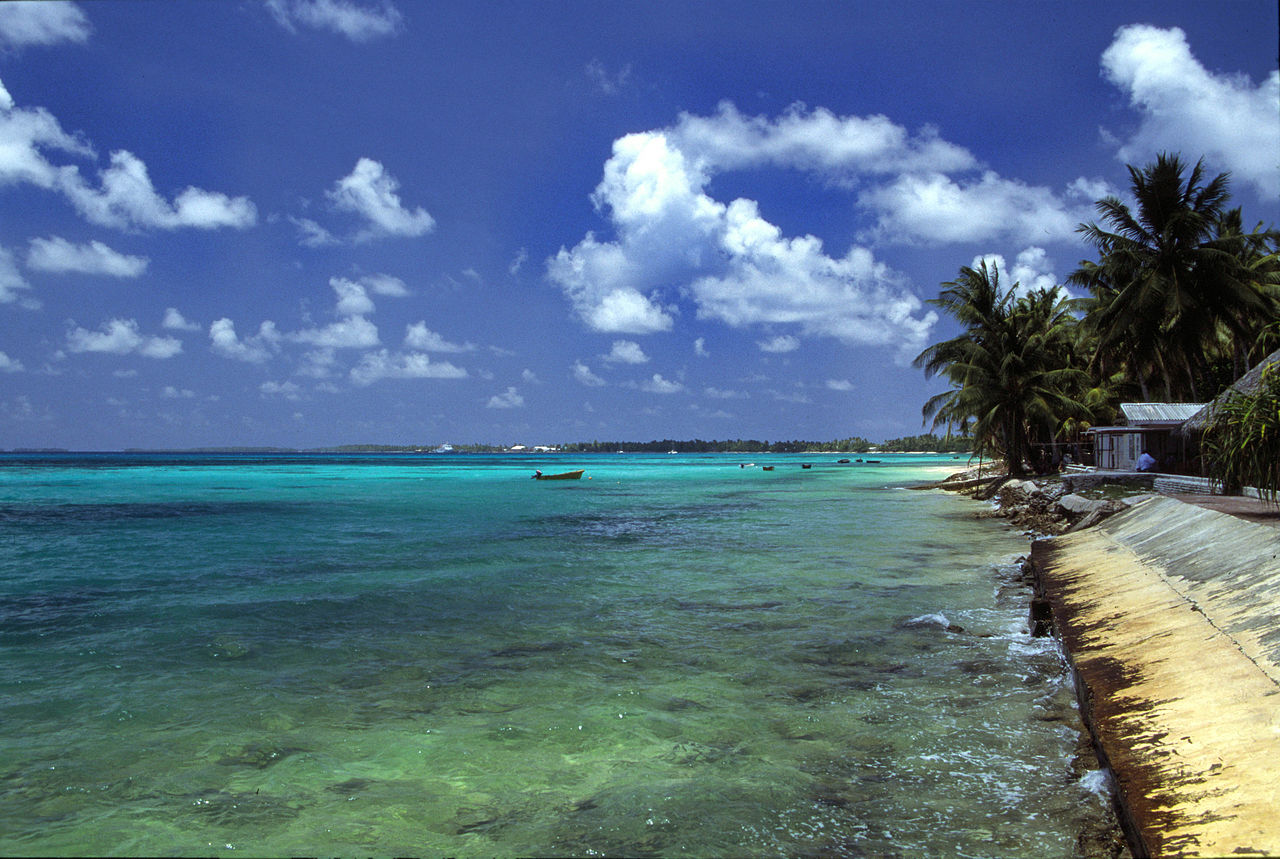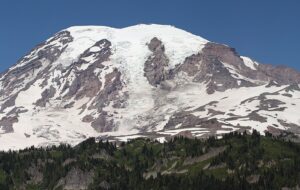The most popular tourist destinations are, unsurprisingly, large, well-known countries. France, Spain, and the United States see hundreds of millions of visitors annually. Nations at the bottom of the list are a little more obscure, but Tuvalu is the world’s least-visited country. Its all-time high came in 2019, when 3,600 tourists set foot on one of its nine islands. By 2021 — admittedly, the tail end of the COVID era — that number had dropped to 41.
Time is also running out for the small island nation. By mid-century, those few tourists may have to visit using scuba equipment.
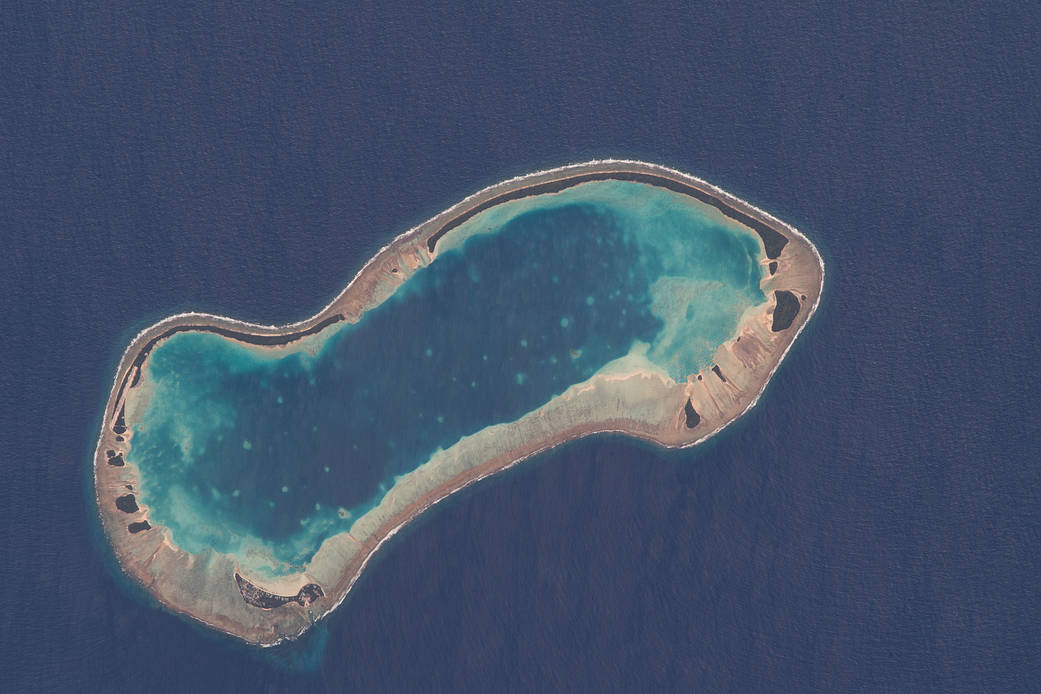
The Niuoku Islet, one of nine small islands that make up Tuvalu. Photo: NASA
First, a backgrounder on Tuvalu
Tuvalu has a total area of 26 square kilometers and lies in the middle of the Pacific, about halfway between Australia and Hawaii. Its nine islands, all coral formations, spread out in a long chain. Three are coral islands, while the rest are atolls, ring-shaped islands formed when an island encircled by coral is worn away, leaving only the coral outline behind.
A majority of the population lives on Funafuti, an atoll made up of several small islets. The entire atoll is officially considered the nation’s capital, and its 2.4 square kilometers (divided between 33 islets) are home to the nation’s parliament, bank, courthouse, police department, library, airport, and hospital.
Despite its status as the least-visited, Tuvalu does have a tourist industry. Visitors can catch one of three weekly flights from Fiji or the weekly route from the Micronesian nation of Kiribati. English is one of the official languages, alongside the Polynesian language of Te Gana Tuuvalu, or Tuvaluan. Likewise, while the nation does have its own coins, Australian currency — in cash — is the main form of legal tender.
The few tourists who do make it out there can explore the marine conservation area, go diving in the lagoons, visit historical sites, watch traditional dances, and buy local handcrafts. There is also a stamp museum.
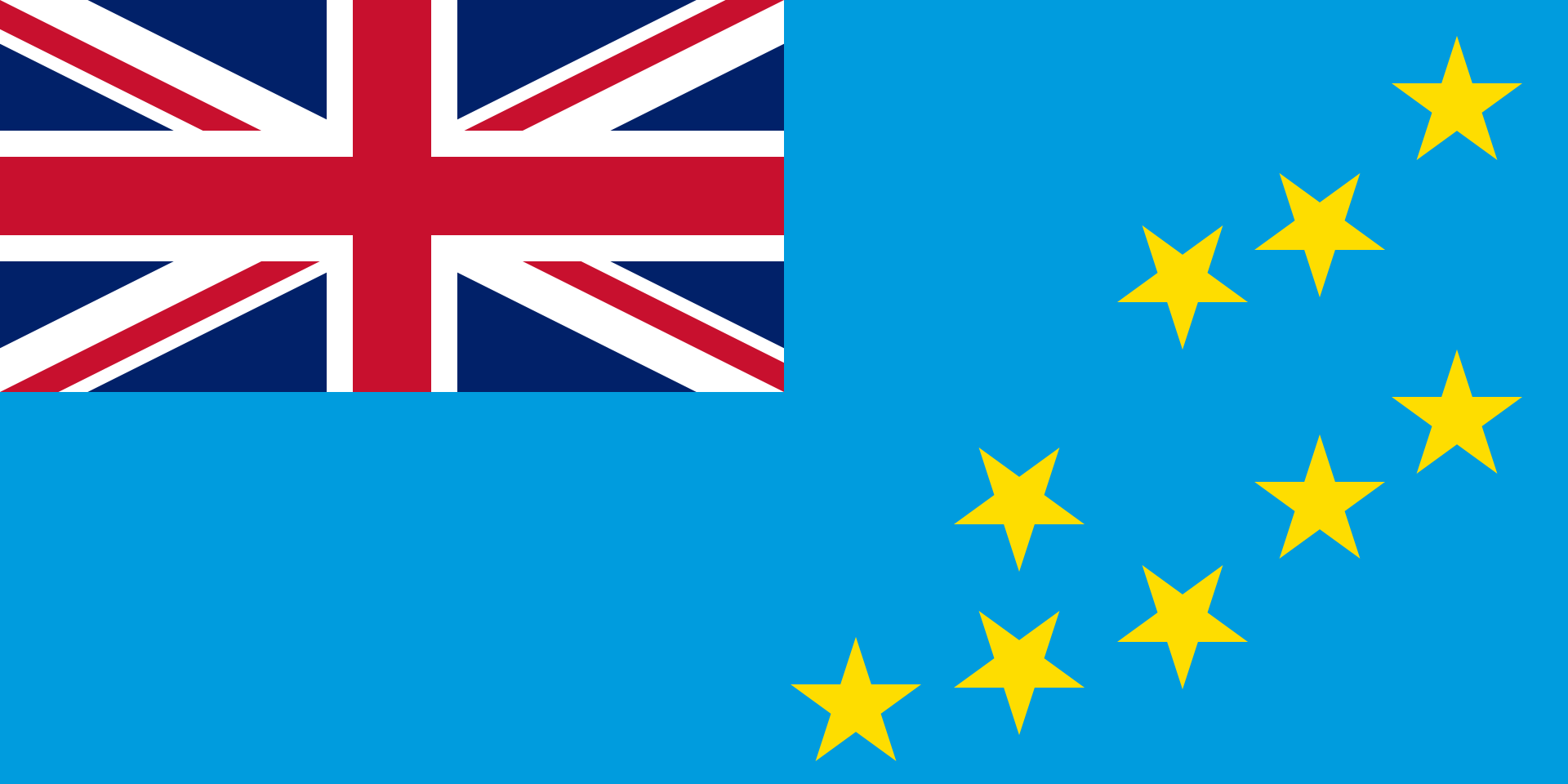
The flag of Tuvalu sports a Union Jack in the upper left, designating it a member of the Commonwealth. The nine stars represent the nine islands. Photo: Public Domain
A brief history of Tuvalu
Several thousand years ago, Polynesian sailors began migrating across the Pacific Ocean. By 900 BCE, they had discovered and settled in Fiji, Samoa, and Tonga. From there, these different groups continued island hopping, landing in Tuvalu, which became an important stepping stone on the way to Micronesia.
However, the people of different islands give different answers as to which groups settled them. The people of Niutao, one of the three islands, claim their ancestors were Samoans. Their oral history records that an expedition of Samoans, led by a man named Mataika, arrived sometime during the 12th or 13th centuries CE. The people of Funafuti and Vaitupu also claim their founder was from Samoa.
In the northernmost atoll of Nanumea, oral history remembers people from Tonga settling first. The other islands recall invaders from Tonga being repelled. Whoever arrived first, by the time of first European contact, eight of the nine islands were settled, giving the country its name, Tuvaluan for “eight standing together.”

Hōkūleʻa, a replica waʻa kaulua (Polynesian voyaging canoe) launched in 1975. Its many successful voyages helped show how effective traditional Polynesian sailing was. Photo: Wikimedia Commons
After European contact
Various European navigators sailed past one or another island starting in the 16th century, but other than making a note on the map, they didn’t stay long. The first semi-regular contact came from whalers. Beginning in the 19th century, they stopped by the islands to trade for coconuts.
In 1862, “blackbirders” found the islands. “Blackbirding” was the practice of kidnapping indigenous Pacific Islanders by the tens of thousands to work the plantations of European colonies. Blackbirders took around four hundred people from the islands, transporting them to Peru to fill a labor shortage there.
The first Christian missionary had arrived only a year earlier, but within a decade, Protestantism was well established. In the 1880s, Germany briefly decided it wanted to own the islands, but it didn’t do much about it. So in the 1890s, the Royal Navy sent a ship to land on every island, and thus made Tuvalu a British protectorate. In 1916, they decided to go full colony and bundled it in with the nearby Gilbert Islands.
Its convenient location made Tuvalu a launching point for Allied operations in the Pacific during World War II. This dubious honor won them an American-built airfield and a series of bombings by Japanese forces.
After the war, the colony became independent, leaving the people of Tuvalu minorities in a government dominated by the much larger Gilbert Islands. After decades of lobbying, Tuvalu became an independent nation in 1978. Unfortunately, they may not get a long time to enjoy it.
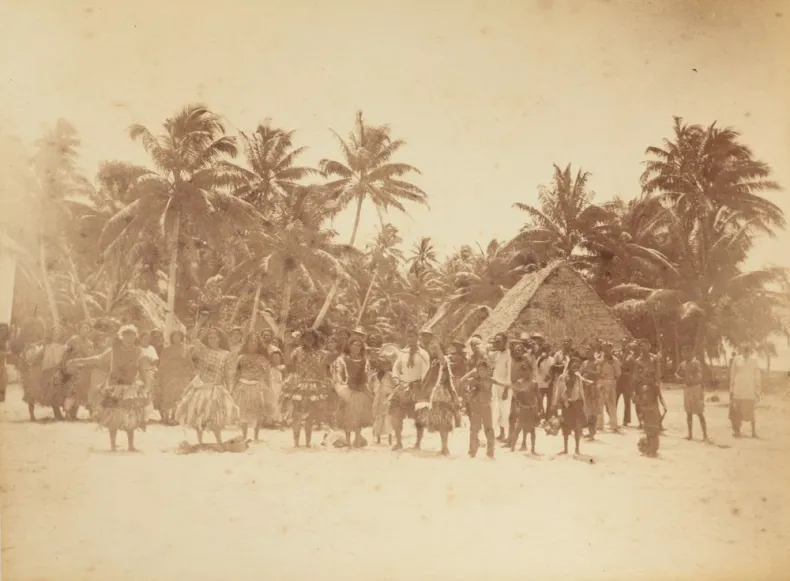
A group of people dancing on Funafuti, from a series of photographs taken by Thomas Andrew in 1886. Photo: Auckland Libraries Heritage Collections
A disappearing land
Most of the islands are only a meter or so above sea level. The highest point in the entire country is 4.5 meters. As sea levels rise, the already tiny country will shrink dramatically. And the waters will rise. NASA analysis found that even if we curb greenhouse gas emissions, some rise in sea level will occur.
Though the millions of people in the South Pacific contribute only a tiny fraction of greenhouse gas emissions, they are feeling the effects of climate change far more than those of us in the Global North. Current estimates predict that by 2100, 90% of Tuvalu will be underwater.
The government and people of Tuvalu are not going gently into any dark, flooded night. In addition to investing in physical mitigation, they’re looking to preserve Tuvalu’s individual selfhood.
In 2023, the government passed a constitutional amendment declaring Tuvalu’s perpetual statehood, despite “climate change or other causes resulting in loss to the physical territory.” In other words, the nation will continue, even if the land is submerged.
By a recent agreement, the governments of New Zealand and Australia offer a combined 355 visas every year to Tuvaluan citizens. While many islanders are determined to stay and do all they can to save their homes, the visas don’t have any problems finding takers. In school, the children of Tuvalu learn about emigration to prepare them for the anticipated move.
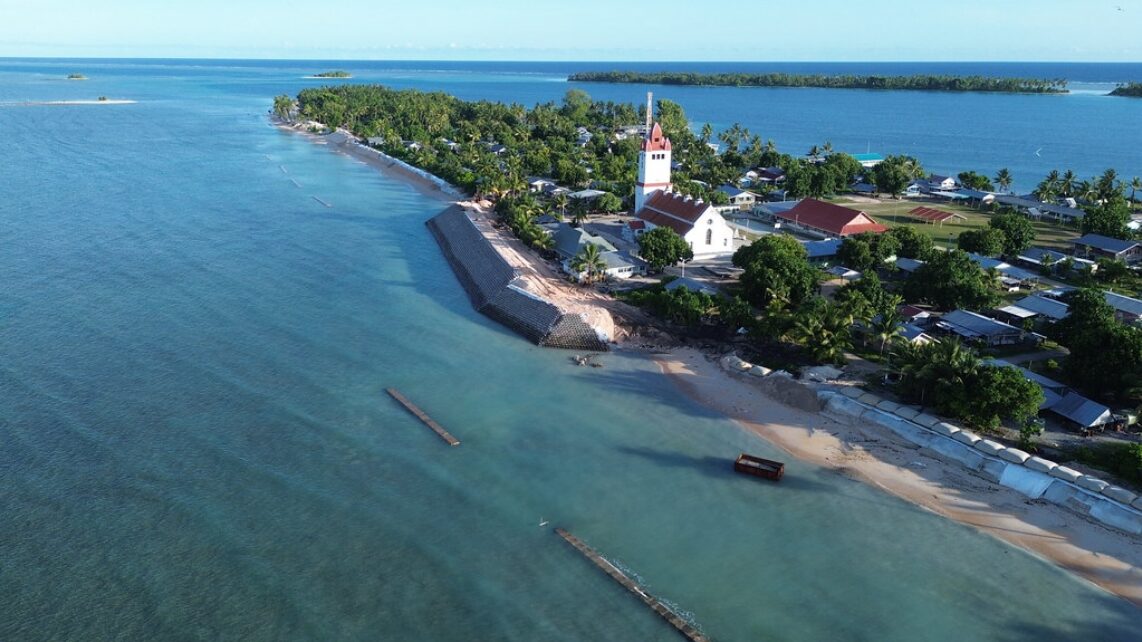
A series of berms and sea walls, like these ones on Nanumea atoll, help slow down erosion and protect infrastructure. Photo: UNDP Climate
Escaping into the internet
But New Zealand isn’t the only planned landing place for the small nation of Tuvalu. In 2021, the nation’s then-Foreign Minister Simon Kofe delivered an address to the UN. In it, he announced a startling new plan to draw international attention to Tuvalu’s crisis: become a digital nation.
For several decades, the internet has been a key part of Tuvalu. Cell service is spotty at best, and few homes have reliable internet, but the nation’s domain suffix of “.tv” has become a hot commodity. Today, a significant chunk of the country’s revenue comes from the sale of .tv domain names.
But what Kofe laid out was much more drastic. One of his goals is to create a complete digital replica of Tuvalu to be archived and saved permanently. This is already in progress. Over the past few years, the nation has successfully made a three-dimensional LIDAR scan of all its islands and islets. The website also aims to serve as a living archive of Tuvaluan history and culture, and a hub for the future diaspora to connect with each other and their heritage.
You can visit Tuvalu — or, at least, the digital version — at www.tuvalu.tv.
